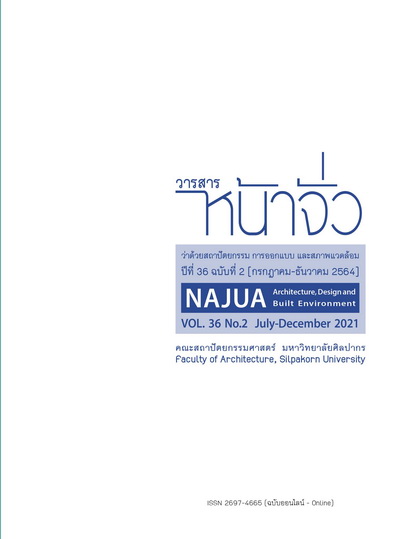นวัตกรรมผนังเศษต้นจาก
คำสำคัญ:
ผนังจากเศษต้นจาก, ผลิตภัณฑ์จากเศษต้นจากบทคัดย่อ
งานวิจัยเรื่องนวัตกรรมผนังเศษต้นจาก มีวัตถุประสงค์เพื่อยกระดับมาตรฐานผลิตนวัตกรรมจากเศษต้นจาก และได้ผลการทดสอบคุณสมบัติของผลิตภัณฑ์ เช่น ค่าความแข็งแรง ค่าความเสียดทานของผนัง และฝ้าเพดาน โดยมีการนำวัสดุใบจาก และขี้จากมาใช้ในการผลิตแผ่นผนังจากเศษต้นจาก จากนั้นจึงดำเนินการแปรรูปใบจาก และขี้จากด้วยการใช้เครื่องสับย่อยชนิด 8 ใบมีด ทำการขึ้นรูปด้วยเครื่องอัดแผ่น และทำการทดสอบค่าเบื้องต้นตามมาตรฐาน มอก. 876-2547 เปรียบเทียบกับวัสดุเชิงพาณิชย์ 4 ชนิด คือ แผ่นขี้เลื่อยไม้อัด แผ่นยิบซัมไวนิลทัช แผ่นสมาร์ทบอร์ดและกลุ่มวีว่าบอร์ด ผลจากการวิจัย พบว่า แผ่นผนังจากเศษต้นจากมีสภาพการนำความร้อน 0.064 W/m.K ใกล้เคียงกับแผ่นขี้เลื่อยไม้อัด แต่มีความหนาแน่นน้อยกว่าวัสดุเชิงพาณิชย์ชนิดอื่น ค่าความต้านทานแรงดัดชนิดที่ทาเคลือบและไม่ทาเคลือบมีความใกล้เคียงกับแผ่นยิบซัมไวนิลทัชและแผ่นสมาร์ทบอร์ด แต่ต่ำกว่ากลุ่มวีว่าบอร์ดและแผ่นขี้เลื่อยอัด ความสามารถในการซึมน้ำต่ำกว่าแผ่นยิบซัมไวนิลทัช แผ่นขี้เลื่อยไม้อัด และแผ่นสมาร์ทบอร์ดแต่จะสูงกว่ากลุ่มวีว่าบอร์ด ส่วนค่าการพองตัวด้านข้างมีค่าสูงกว่าแผ่นยิบซัมไวนิลทัช แผ่นสมาร์ทบอร์ด และแผ่นวีว่าบอร์ดแต่ต่ำกว่าแผ่นขี้เลื่อยไม้อัด จึงสรุปได้ว่าแผ่นผนังจากเศษต้นจากเหมาะสำหรับใช้งานภายในอาคารในพื้นที่ที่ไม่โดนน้ำเนื่องจากความชื้นสูงทำให้แผ่นผนังจากเศษต้นจากมีการพองตัว และเสียรูปในการใช้งานได้
เอกสารอ้างอิง
Cooper, D. and Schindler, P. (2011). Business Research Methods. 11th Edition, Boston: McGraw Hill.
Janamphon Yongyut. (2009). Panangyaiklouy. [in Thai] [Banana fiber wall]. BKK: Kasetsart University Research and Development Institute.
Khamyingyong Piyaporn. (2015). Maximizing the Value of Material scraps and Turning into Eco Products, Case Study: Home Decoration Products from Wood scraps. BKK: Bangkok university.
Khiaomang Kriangsak. (2007). Application of old plaster mould in ceramics to product design. Master Degree Thesis in applied arts (product design). Ubon Ratchathani: Ubon Ratchathani University.
K. T. Ulrich and S. D. Eppinger. (1995). Product Design and Development. McGraw-Hill. International Editions. pp. 19-95.
Krishnan, V., & Ulrich, K. T. (2001). “Product development decisions: A review of the literature”. Management Science. 47(1). pp. 1–21.
McCarthy, E. Jerome and Perreault, William D. (1991). Essential of Marketing. (5th ed.). Boston: E. Jerome McCarthy and Associates.
Mu, J., Peng, G., & MacLachlan, D.L.(2009). “Effect of risk management Strategy on New product development performance.International”. Journal of Technovation. Vol. 29. pp. 170 – 180.
Praneetpolgrang Prasong. (2004). Kanborihan kanparit laekanpatibatkan. [in Thai] [Production and operations management]. Bangkok: Thanathud Print.
Saribut Udomsak. (2006). Technology palittaphan usahakam. [in Thai] [Industrial Product Technology]. Bangkok: OS Printing House.
Suwanasree Sajee. (2008). Principle of Product Development and Sensory Evaluation. Phitsanulok: Department of Agriculture Science Faculty of Agri culture Natural Resources and Environment, Naresuan University.
ดาวน์โหลด
เผยแพร่แล้ว
รูปแบบการอ้างอิง
ฉบับ
ประเภทบทความ
สัญญาอนุญาต

อนุญาตภายใต้เงื่อนไข Creative Commons Attribution-NonCommercial-NoDerivatives 4.0 International License.





